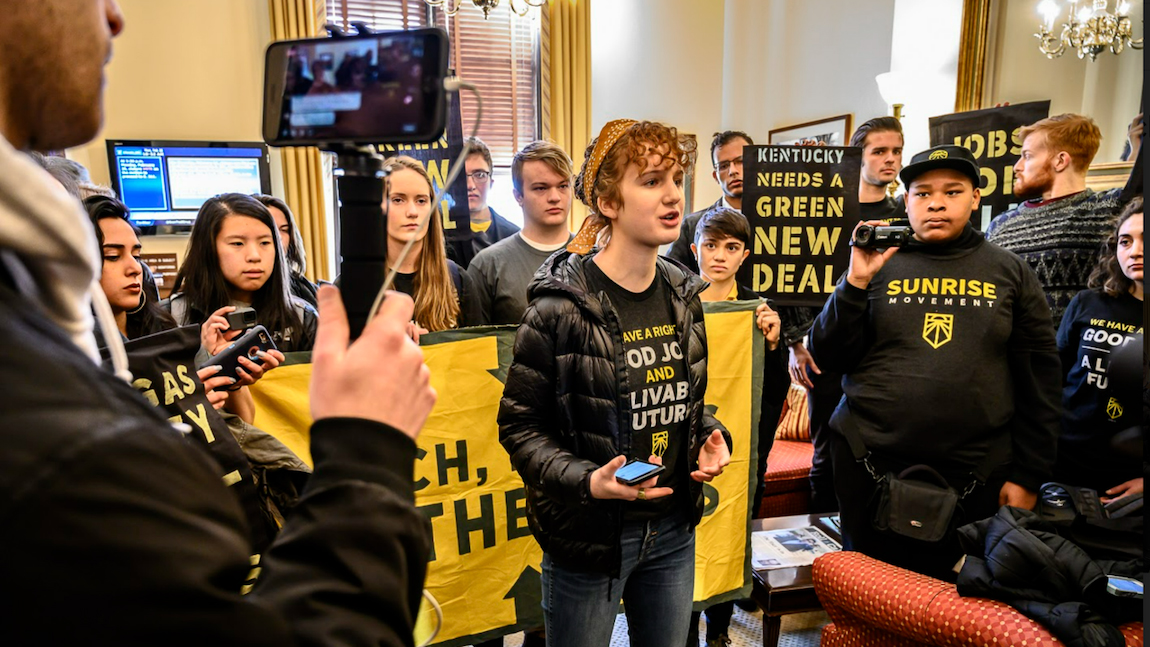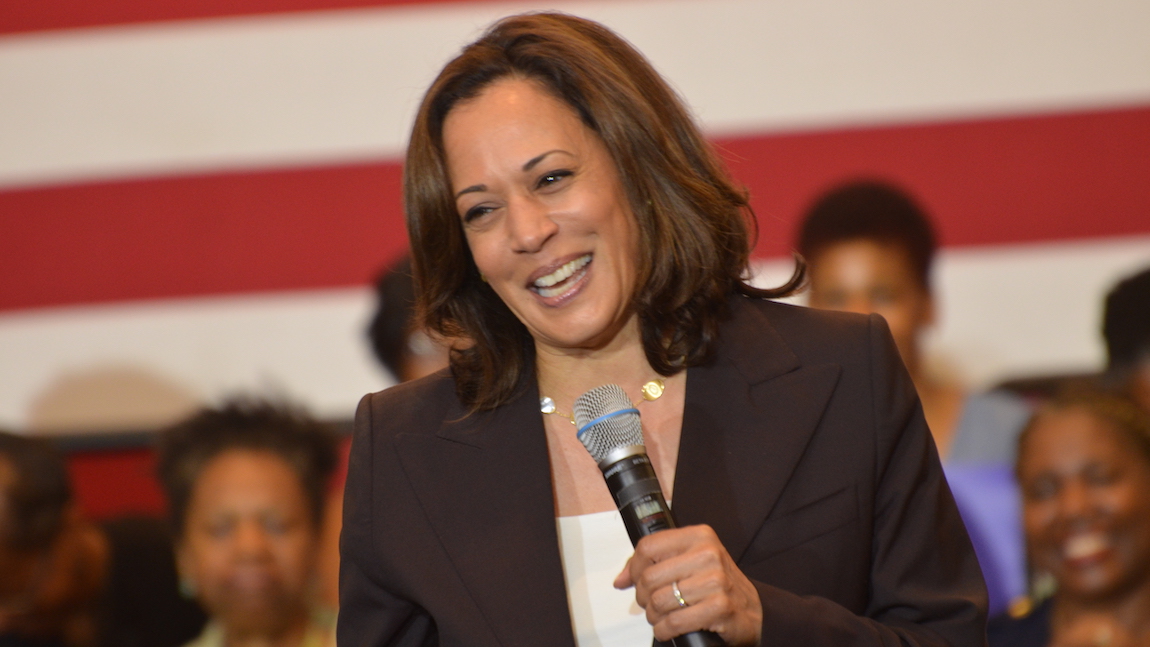By Dr. Jeremy Holland
- Since 2018, a youthful environmental organization known as the Sunrise Movement have been active in protesting for the adoption of a federal policy known as the Green New Deal.
- The Green New Deal aims to urgently address the global climate crisis and ensure good-paying jobs for all Americans while rebuilding the energy sector in the United States.
- So far, the Green New Deal proposal has not been approved by Congress, but the Sunrise Movement are not backing down and are intent on securing a sustainable future for all Americans.
There are many groups under the larger umbrella of the environmental justice movement whose main goal is to make a long-term impact by convincing citizens to take a more drastic approach to cleaning up the global environment. Recently, a youth-led environmental group called the Sunrise Movement has emerged in the national spotlight. A week following the 2018 midterm elections, 250 young people descended on the country’s capital and stormed the offices of Speaker Nancy Pelosi calling for a Green New Deal (GND) with a just transition to 100% renewable energy in the U.S. by 2030.
The mission of Sunrise is to build an army of young people to make climate change and urgent national priority, oust the corrupting political influence of fossil fuel executives, and elect leaders who stand up for the wellbeing of everyone. In their view, the climate disaster is not coming sometime in the future, it is already upon us. Therefore, they are backing a GND resolution that proposes a ten-year economic mobilization that will rapidly transition the US to a zero-carbon economy.
In the Green New Deal Resolution, which has 95 House and 14 Senate co-sponsors, the idea that we have to choose between a booming economy or a more sustainable environment is a false choice. In fact, Sunrise members envision that by implementing a Green New Deal, workers in the U.S. will have the opportunity to move into a more technologically advanced job market with good-paying jobs, while simultaneously tackling the climate debacle.
When it comes to economic policy, GND thinkers are influenced by previous environmental movements, the histories of World War II and the New Deal, and a body of economic theory called the new consensus. In essence, they believe that the U.S. government must perform essential tasks in steering the national economy, and the GND seeks to facilitate these tasks by rebalancing the relationship between the public state and the private market.
Market Fundamentalism Blocks GND Progress
The economic framework that is holding back progress on securing the GND for all Americans and ensuring a sustainable future is known as market fundamentalism (or neoliberalism).
In this system, industrial giants are granted the power to burn fossil fuels without limit. As a result, corporations can override the will of the people, thereby condemning some peoples and places to pollution disaster and death.
We know, thanks to the research from the Climate Accountability Institute, that a whopping 71 percent of total greenhouse gas emission since 1988 can be traced to just one hundred corporate and state fossil fuel giants, dubbed the Carbon Majors. A few of these carbon majors include Chevron, ExxonMobil, BP, and Shell.
In 2018 the Intergovernmental Panel on Climate Change, the United Nation’s body of environmental scientists, released a shocking report revealing that human activity has been the dominant cause of climate change over the last century. This rapid climate change is causing sea levels to rise and an increase extreme weather events that threaten healthy communities and critical infrastructure.
Moreover, if global warming reaches 2 degrees Celsius above preindustrial levels we will see mass migration, wildfires occurring at double the rate by 2050, a loss of nearly all coral reefs on earth, damage of $1trillion worth of public infrastructure and coastal real estate in the U.S., and $5 billion of lost annual economic output in the U.S. by the year 2100. To avert is disastrous scenario, global reductions of greenhouse gas emissions must be reduced by 60 percent by 2030 and move into net-zero global emissions by 2050.
Today, we still have a long way to go considering the composition of the American energy sector. Currently, only 19 percent of the energy consumed in the U.S. comes from renewable resources. For instance, electric vehicles account for only 2 percent of all cars sold, and our buildings still produce approximately 40 percent of our nation’s carbon dioxide emissions.
The “New Deal” of the GND
The single most determining factor in whether a GND mobilization pulls us back from the climate cliff will be the actions taken by social movements in the coming years. It must always be remembered that President Franklin D. Roosevelt rolled out the New Deal during a historic wave of labor unrest, which has provided all Americans since then with social security benefits and unemployment insurance.
A federal jobs guarantee is central to the mission of a Green New Deal. This gets to the “New Deal” portion of the plan harkening back to the strategy employed by the Franklin D. Roosevelt administration during the Great Depression Era when a quarter of all Americans were out of work. Recent polling shows strong bipartisan support for a federal jobs guarantee. Sixty-four percent of likely voters, including 78 percent of Democrats and 53 percent of Republicans, said they would support a federal jobs guarantee program as part of the government’s response to the economic crisis.
The climate scientists are telling us to stem the tide of ever-rising carbon output and avert the worst disasters, the U.S. must be willing to transition to 100 percent renewable energy within the next eight years. This ambitious program will jump start our next industrial revolution as the U.S. will need 78 million solar panels, 485,000 wind turbines, and 48,000 solar power plants to generate about 95 percent of all energy from renewable resources. The task of building these technologies will provide jobs for millions of Americans.
Implementing the GND will turn the U.S. into a jobs creating machine. Even without federal support, the green economy is already creating many more jobs than oil and gas. According to the 2020 US Energy and Employment Report, jobs in wind, solar energy efficiency, and other clean energy sectors outnumbered fossil fuel jobs by a rate of three to one. That is happening because of a combination of state and municipal incentives and the plummeting costs of renewables.
Relevance of the Sunrise Movement
In the Summer of 2021, members of the Sunrise Movement marched over 600 miles across the Gulf South and California advocating for a robust Civilian Climate Corps. The Civilian Climate Corps is a vision of a federal jobs program that will put the younger generation to work addressing climate change. They marched across the country meeting community leaders along the way that have been most impacted by the climate crisis, hosted visioning sessions about a GND future, and told their stories of living through climate change in the present.
The youthful Sunrise Movement reminds us that the future survival of our hospitable planet demands that we come to terms with our lifestyle choices in a culture of easy consumption. If we are intentional in setting up the next phase of our economy, then our planet’s resources can provide us with both private sufficiency and public luxury, in the forms of wonderful parks public sports centers, galleries, and public transport networks. The earth cannot, however, sustain the impossible dream of private luxury for all.
A climate disrupted future is a bleak future, one capable of turning all our material possessions into rubble with terrifying speed. We can pretend that extending the status-quo into the future, unchanged, is one of the options available to us. But that is a fantasy. Change is coming one way or another. Our choice is whether we try to shape that change to the maximum benefit of all or wait passively as the forces of climate disaster and resource scarcity fundamentally reshape us.
Editor’s Note:
This is the sixth of an ongoing series of social movement profiles by Dr. Jeremy Holland, who teaches sociology at Horry Georgetown Technical College.






